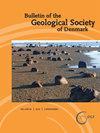挪威南部Skien–Langesund区Porsgrun岩芯中寒武纪明矾页岩组的地层和地球化学组成。
IF 1
4区 地球科学
Q2 Earth and Planetary Sciences
引用次数: 19
摘要
全取芯BHD-03-99钻孔(以下简称为Porsgrun钻孔和岩心)穿透了挪威奥斯陆地区南部Skien–Langesund区的奥陶系和寒武纪地层。对中寒武纪-芙蓉期明矾页岩地层进行了手持式X射线荧光(HH-XRF)测量,并结合光谱伽马射线和密度岩心扫描,将其与在斯堪尼亚(瑞典最南端)和博恩霍尔姆(丹麦)的明矾页岩岩心上获得的类似测量结果进行了比较。Porsgrun钻探场地位于一个仅被喀里多尼亚构造轻度叠加的区域,是奥斯陆地区少数几个可以从厚度和地球化学角度研究几乎未经构造的沉积序列的场地之一。Porsgrun岩芯中的明矾页岩层厚度为28.8 m,不包括五个0.9–5.5 m厚的假定二叠纪粗玄岩岩床的厚度。在明矾页岩地层中,体积密度约为2.7 g/cm3,整个地层呈略微下降的趋势。页岩的总有机碳(TOC)值高达14 wt%,与奥斯陆地区其他地方的明矾页岩以及斯堪尼亚和博恩霍尔姆的干气成熟明矾页岩的TOC水平相当。芙蓉纪基底的特征是伽马射线低和Mo的增加,这被解释为反映了Steptoean正碳同位素漂移(SPICE)事件。Porsgrun核心数据表明,在SPICE事件之后,Mo浓度仍然很高。伽马测井基序中易于识别的特征被命名为安德鲁姆伽马低(AGL)、芙蓉基底伽马低(BFGL)、Olenus三重伽马尖峰(OTGS)和Peltura伽马尖峰(PGS)。不存在下奥陶统明矾页岩。根据Scania和Bornholm的测井地层对比,Alum页岩14.8 m厚的Furongian部分代表Olenus、Parabolina、Leptoplastus、Protopeltura和Peltura三叶岩超带。中寒武纪层段厚度14.0 m,包括Exsulans石灰岩层和1.4 m石英砂岩。0.3m厚的原生石灰岩层可能相当于安德鲁姆石灰岩层。该序列代表了Paradoxides paradoxisimus和P.forchhammeri超带。Alum页岩组位于13.0 m厚的下寒武纪Stokkevannet砂岩(新的非正式名称)之上,该砂岩又直接覆盖在基底之上。总体而言,相对较薄的明矾页岩组的地层发育类似于Bornholm上的浓缩序列。本文章由计算机程序翻译,如有差异,请以英文原文为准。
Stratigraphy and geochemical composition of the Cambrian Alum Shale Formation in the Porsgrunn core, Skien–Langesund district, southern Norway.
The fully cored BHD-03-99 borehole (hereafter referred to as the Porsgrunn borehole and core) penetrated Ordovician and Cambrian strata in the Skien–Langesund district, southern part of the Oslo region in Norway. Hand-held X-ray fluorescence (HH-XRF) measurements combined with spectral gamma ray and density core scanning of the Middle Cambrian – Furongian Alum Shale Formation have been made and compared with similar measurements obtained on Alum Shale cores from Scania (southernmost Sweden) and Bornholm (Denmark). The Porsgrunn drill site is located in an area that was only mildly overprinted by Caledonian tectonics and represents one of the few sites in the Oslo area where a nearly untectonised sedimentary succession can be studied in terms of thickness and geochemistry. The Alum Shale Formation is 28.8 m thick in the Porsgrunn core, excluding the thickness of five 0.9–5.5 m thick dolerite sills of assumed Permian age. In the Alum Shale Formation the bulk densities are around 2.7 g/cm3 with a slightly decreasing trend up through the formation. The shale has total organic carbon (TOC) values up to 14 wt%, which is comparable to the TOC levels for the Alum Shale elsewhere in the Oslo area and for dry gas matured Alum Shale in Scania and Bornholm. The basal Furongian is characterised by a gamma ray low and an increase in Mo interpreted to reflect the Steptoean Positive Carbon Isotope Excursion (SPICE) event. The Porsgrunn core data suggest that the Mo concentration remained high also after the SPICE event. Characteristic, readily identified features in the gamma log motif are named the Andrarum gamma low (AGL), base Furongian gamma low (BFGL), Olenus triple gamma spike (OTGS) and the Peltura gamma spike (PGS). No Lower Ordovician Alum Shale is present. The 14.8 m thick Furongian part of the Alum Shale represents the Olenus, Parabolina, Leptoplastus, Protopeltura and Peltura trilobite superzones judging from log-stratigraphic correlations to Scania and Bornholm. The Middle Cambrian interval is 14.0 m thick and includes the Exsulans Limestone Bed and 1.4 m of quartz sandstone. A 0.3 m thick primary limestone bed may be an equivalent to the Andrarum Limestone Bed. The succession represents the Paradoxides paradoxissimus and P. forchhammeri superzones. The Alum Shale Formation rests atop the 13.0 m thick Lower Cambrian Stokkevannet sandstone (new informal name) that in turn directly overlies the basement. Overall, the stratigraphic development of the comparatively thin Alum Shale Formation resembles the condensed sequence seen on Bornholm.
求助全文
通过发布文献求助,成功后即可免费获取论文全文。
去求助
来源期刊

Bulletin of the Geological Society of Denmark
GEOSCIENCES, MULTIDISCIPLINARY-
CiteScore
2.80
自引率
16.70%
发文量
28
审稿时长
>12 weeks
期刊介绍:
The Bulletin publishes contributions of international interest in all fields of geological sciences on results of new work on material from Denmark, the Faroes and Greenland. Contributions based on other material may also be submitted to the Bulletin if the subject is of relevance for the geology of the area of primary interest.
 求助内容:
求助内容: 应助结果提醒方式:
应助结果提醒方式:


